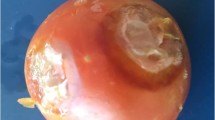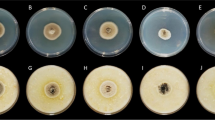Abstract
Among 39 fungal species and one variety belonging to 16 genera isolated from 116 healthy tomato fruits collected from markets in Assiut, Egypt, during 1994,Aspergillus niger was found to be the most prevalent, being isolated from 84.6% of the samples. Of 11 species recovered from 156 diseased tomatoes,Alternaria alternata, Rhizopus stolonifer andA. niger were the most common and isolated from 52.7%, 35.9% and 25.0% of the samples, respectively. Experiments for comparison of the effects of medium containing tomato juice with synthetic medium on the mycelial growth of nine fungal species indicated that, the tomato juice medium was more suitable for growth of all fungal species. The effect of five commercial fungicides and sodium hypochlorite when applied as post-harvest dips after inoculation was studied in laboratory againstA. alternata, A. niger andR. stolonifer. At 10 and 100 µg ml−1, neither of the fungicide caused a noticeable inhibition ofAlternaria rot. At 1000 µg ml−1 benlate, rovral and sumisclex completely preventedAlternaria andAspergillus rot, whereas cuprosan and ridomil were ineffective against rotting caused byA. niger. Rhizopus rot development was inhibited by over 50% with one treatment only (rovral at 1000 µg ml−1). Sodium hypochlorite has good curative properties against fruit rots especially those caused byA. alternata andA. niger.
Similar content being viewed by others
References
Araya CM, Rivera, Campos D. Identification and pathogenicity of fungi associated with tomatoes (Lycopersicon esculentum Mill.) from the field and market in Costa Rica. Fitopatologia 1988; 23: 1–4.
Arize AE. Post-harvest diseases of tomato fruits in Southern Nigeria. Fitopatologia. Brasileira 1986; 11: 637–45.
Chinoko Y, Naqvi SHZ. Studies on fungi associated with post-harvest rot of tomato (Lycopersicon esculentum Mill.) in south west Nigeria. Nigerian Journal of Botany 1989; 2: 9–17.
D'Ercole N, Bernardoni C, Nipoti P, Sportelli M. Fungal rots of tomato fruit while still on the plant. Informatore Agrario 1984; 40: 67–70.
Mathey MD, Oriolani EJA. Fruit rot of tomato caused byRhizoctonia solani Kühn in the Republic of Agrentina. IDIA 1985: 48–9.
Rath GC, Mishra D, Nandi RK, Mohanty S, Sahoo RC. Fungal rots of tomato in Orissa markets. Orissa Journal of Agricultural Research 1990; 3: 9–12.
Oladiran AO, Iwu LN. Studies on the fungi associated with tomato fruit rots and effects of environment on storage. Mycopathologia 1993; 121: 157–61.
Prasad BK, Sinha TSP, Narayan N. Influence of temperature on the soft rot of tomato fruits due toSclerotiwn rolfsii. Indian Phytopathology 1988; 41: 256–7.
Rod J, Popelka V.Trichotheciwn roseum. Link ex Fr. as the pathogen of fruit rot of tomato. Ochrana Roszlin 1983; 19: 113–4.
Rodigin VM, Grin'ko NN. Rhizoctoniose rot of tomato fruits. Zashchita Rastenil (Moskva) 1990; 11: 40–1.
Abdel-Gawaad TI. Cladosporium rot disease of tomato fruits in Egypt. Assiut Journal of Agricultural Sciences 1993; 24: 189–205.
Okoli CAN, Erinle ID. Factors responsible for market losses of tomato fruits in Zaria area of Nigeria. Journal of Horticultural Science 1989; 64: 69–71.
Abdel-Rehim MA, Ibrahim IA, Wasfi S, Hassouna MS. Some changes in tomato fruits due to infection byAlternaria alternata andGeotrichum candidum. Egyptian Journal of Phytopathology 1973; 5: 55–64.
Efiuvwevwere BJO, Hobson SE. Quality changes in tomatoes and resistance toAlternaria infection as influenced by varying storage temperature. Journal of Food Science 1989; 54: 376–8.
Glazener JA. Accumulation of phenolic compounds in cells and formation of lignin-like polymers in cell wall of young tomato fruits after inoculation withBotrytis cinerea. Physiological Plant Pathology 1982; 20: 11–25.
Rattan RS, Saini SS. Association of fruit rot resistance with ascorbic acid content in tomato (Lycopersicon esculentum Mill.). Vegetable Science 1979; 6: 54–6.
Reddy SM, Kumar BP, Reddy SR. Vitamin C changes in infected fruits of tomato. Indian Phytopathology 1980; 33: 511–2.
Cartia G. The use of dicarboximides against grey mould of tomatoes in protected cultivation. Colture Protette 1985; 14: 55–6.
Hall DJ. Post-harvest treatment of Florida fresh market tomatoes with fungicidal wax to reduce decay. Proceedings of the Florida State Horticultural Society 1989; 102: 365–7.
Leandri A, Imbroglini S, Conte S. Influence of fungicide formulations on residue levels. Difesa della Piante 1990; 13: 3–10.
Moline HE. Comparative studies of twoMucor species causing post-harvest decay of tomato and their control. Plant Disease 1984; 68: 524–6.
Spalding DH. Control ofAlternaria rot of tomatoes by post-harvest application of Imazalil. Plant Disease 1980; 64: 169–71.
Thapa CD, Sharma SL. Chemical control of fruit rot diseases of tomato. Indian Journal of Plant Protection 1978; 6: 76–8.
Spalding DH, King JR. Inhibition ofAlternaria rot of tomatoes and bell peppers by post-harvest treatment with CSA-64251 or imazalil. Proceedings of the Florida State Horticultural Society 1980; 93: 307–8.
Adisa VA. Control of four post-harvest tomato fruit rots in Nigeria by oils. Indian Phytopathology 1985; 38: 270–7.
Daradhiyar PK. Studies on some post-harvest diseases of tomato and their control. Journal of the Indian Botanical Society 1980; 59: 230–3.
Okoli CAN, Erinle ID. Comparative rate of rot-induction by nine fungal pathogens on stored tomato fruits in Nigeria. Journal of Stored Products Research 1990; 26: 77–9.
Singh JP, Bhatngar DK, Lal S. Effect of different fungicides on microbial decay and keeping quality of tomato fruits during storage. Haryana Journal of Horticultural Science 1988; 17: 69–73.
Prasad S, Mishra B, Gupta U, Rai KK. Evaluation of some chemicals on control of soft rot of tomato fruits. Journal of Research, Birsa Agricultural University 1989; 1: 175–8.
Bartz JA. Potential for post-harvest disease in tomato fruit infiltrated with chlorinated water. Plant Disease 1988; 72: 9–13.
Author information
Authors and Affiliations
Rights and permissions
About this article
Cite this article
Abdel-Mallek, A.Y., Hemida, S.K. & Bagy, M.M.K. Studies on fungi associated with tomato fruits and effectiveness of some commercial fungicides against three pathogens. Mycopathologia 130, 109–116 (1995). https://doi.org/10.1007/BF01103459
Received:
Accepted:
Issue Date:
DOI: https://doi.org/10.1007/BF01103459




